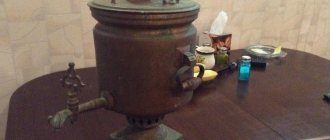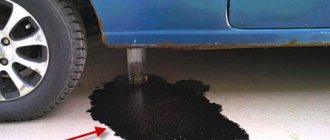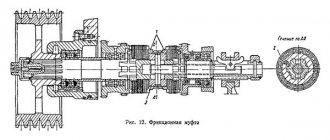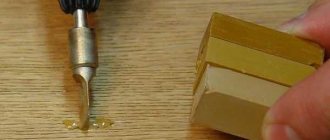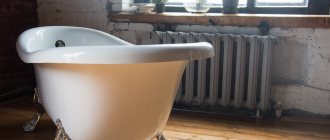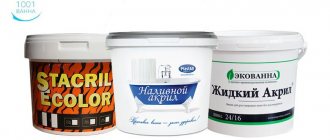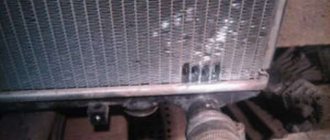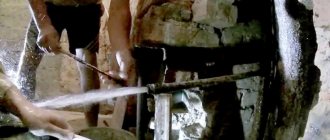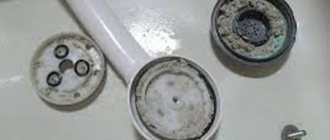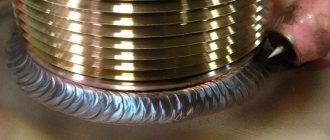Such an original piece of furniture, like a samovar, evokes a flair of antiquity in the room and creates a special noble atmosphere
Today, in very rare cases, a samovar is used as a water heating device. If we are talking about an electric samovar, then it performs its functions to a greater extent, but even repairs will not save the so-called grandmother’s samovars (in the sense that they are unlikely to brew tea in them). That’s right, the samovar today is a luxurious interior element. Both in the kitchen and, in some cases, in the living room, it can become a design highlight. But here it would be appropriate to talk about such a concept as the restoration of samovars, because it is the transformation of these utensils that is consonant with the decorative purposes of using samovars.
Repairing samovars with your own hands: how to do it right
If we talk about major repairs, that is, not only decorative ones, they can consist of many points.
Samovar repair may include:
- Body straightening;
- Elimination of causes of leaking pipes and taps, handles, etc.;
- Elimination of cracks;
- Anti-scale;
- Tinning;
- Replacement of samovar parts with preliminary selection;
- Cleaning the body;
- Final polishing of the case after cleaning.
Repair or restoration of a samovar also includes the replacement of a pipe with preliminary selection.
Restoration is usually carried out by professionals, but if you know some of the basics of the technology for repairing such things, independent repair and restoration are quite possible.
By the way, if you are the owner of an old samovar with a volume of 15-20 liters, even the highest quality restoration is unlikely to help it become a functioning item for tea drinking. Well, if you are going to restore small samovars, then it is quite possible to return them to their original functionality.
How samovars are restored (video)
Faucet repair
In old samovars, the faucet is often stuck or leaking. You can solve these problems as follows:
- If the faucet does not turn, you can lubricate it with WD-40. After this, wait a few minutes and tap the faucet handle through a wooden block to activate it.
- If the faucet key is leaking from below, it means it is set too high. This can be corrected using “Valve” paste. It is necessary to remove the faucet, wash it, rub it with paste, and install it back. Then fill the samovar with boiling water and turn the tap in a circle until it “sits” in its place. The main thing is to act smoothly so that the key does not fall inside.
- If the faucet key is leaking from above, it must be replaced with a new one; there are simply no other options for action in such a situation. It looks like the faucet body has worn out and shrunk in size.
Tinning a samovar: we do it ourselves
Metal utensils have one not very pleasant property - air and ordinary food products act in such a way that over time the surface of such utensils oxidizes. And oxidation entails covering the surface with a film, which poses a certain threat to human health.
To prevent such a misfortune from happening to your samovar, you need tinning. That is, the surface of the samovar, the one that comes into contact with water, will be covered with a layer of metal that is less susceptible to external influences. Most often, such a layer is represented by tin, and the process of coating with tin is called tinning. By the way, not only a samovar, but also an ordinary pot, a cast iron pot, can be subjected to this preventive procedure, which is neither particularly expensive nor very complicated.
Tinning is one of the most important restoration stages
Tinning a samovar at home:
- Clean the inner surface of the samovar with sandpaper - dirt and oxidation will probably accumulate there.
- After this, the inside of the samovar must be rinsed very well with water.
- Then you need to rub the inside of the samovar with either ammonia or soldering acid.
- After this, place the samovar on the stove, melt a little tin in it and rub it thoroughly with tow. A layer of poluda (tin coating) should be on the entire internal surface.
- At the end of the work, you must make sure that there is a layer of tin on the entire inner surface, dense and uniform.
If possible, use pure tin for tinning, without harmful impurities such as lead and zinc. Tin can cover not only the inner layer, but also all parts of the samovar that come into contact with water.
Varieties
There are several types of samovar restoration:
- If only the appearance is important and the samovar will be used as an exhibit, then “museum” repairs and restoration of the outer covering are used. Such a device will most likely no longer be able to heat water.
- During partial restoration, individual elements of the product are replaced in order to bring it into working condition, but no attention is paid to appearance.
- During a complete restoration, the external and internal parts of the samovar are replaced, and the coating is also updated.
It is best to entrust this work to specialists, since not everyone can do soldering or tinning with their own hands. You should choose a method for restoring a product based on your needs and the degree of damage. If the samovar is too old and oxidized, and its elements do not function well, then it is recommended to carry out a complete repair.
Decorative restoration of external covering
Replacing internal parts
Complete restoration
Partial
In order to add shine to the oxidized outer surface of the samovar, polishing is required. To do this, you can use specialized products (Metal Polish or its analogues) that are suitable for cleaning brass, copper or aluminum. Folk remedies are also used, for example, soda or fine river sand, but these methods can scratch the surface of the product and are also not very effective compared to professional compositions. If small defects appear, they can be sanded with Goya paste.
If the samovar is too old, with a large layer of oxide that cannot be removed with conventional chemical means, mechanical grinding will be required. It will remove everything unnecessary, but can lead to the formation of a hole if you do not clean it carefully. Tinning is also done to prevent oxidation of the samovar from the inside, and for its external part - nickel or silver plating. This is necessary to prevent corrosion, as well as to add shine and improve appearance.
To check the tank for leaks, fill it with water and melt it. When heated, the metal expands, so the gap may only be noticeable during operation. If the samovar's handles are made of wood or are heavily rusted, they can be replaced with the same ones or ordered new ones (at a factory where products from non-ferrous metals are produced).
Over time, the samovar oxidizes and scale and rust appear on its surface, which must be removed.
Comprehensive
Complex restoration of a samovar includes processes similar to partial repair, but other methods are also used. Most often, with this restoration option, all fittings, non-working spare parts, as well as those that look bad, are replaced with new ones or carefully restored. All dents are removed from the surface of the product, and the places where they were are checked for microcracks. The inside of the samovar is descaled using chemicals or citric acid. After this, it is degreased and tinning is carried out.
The outer surface is also restored. It is cleared of oxide and plated with nickel or silver. The samovar needs to be checked for holes and microcracks along the entire surface in order to find leaks and seal them with food solder.
If water leaks from the bottom of the faucet, this means that the key sits too high in it and requires grinding.
All parts must be removed from the housing
New handles can be turned from the wood you have on hand
Everything inside should be tinned with clean tin.
A propane and oxygen torch will be useful for assembly.
All parts must be thoroughly cleaned and checked for cracks before assembly.
Faucet assembly
How to get rid of scale in a samovar: the right method
Without solving this problem, repairing the samovar is not possible. Scale is a sediment that appears as a result of boiling low-quality water. In fact, you can use synthetic products from the mass market designed to remove scale from electric kettles. But you can also make your own anti-scale product or several at once.
To get rid of scale in a samovar, you will need:
- Any store-bought product with a minimum of ingredients (cheap and relatively natural);
- Lemons;
- Lemon acid;
- Vinegar;
- Potato peelings.
The first method is the simplest, but not the most environmentally friendly. Subject the samovar to the actions prescribed by the instructions on the device. Be sure to rinse it with water after all manipulations are completed.
Boiling the carbonated drink “Sprite” in it for several minutes will help you easily get rid of scale in a samovar.
Second method: pour a whole bottle of acetic acid into a filled samovar, heat the water in the samovar to 60 degrees, do not boil. Let this mixture sit in the samovar for about an hour, then rinse off. Other acids should not be used, they are more aggressive. That is, their danger lies not only in particles that may remain on the walls of the samovar, but also in toxic vapors during the action of acid.
In what cases is it necessary
Repair of samovars may be required in case of mechanical damage to the products (dents, holes), as well as oxidation or scale formation on the surface of the containers. The inside of the tank must be covered with a protective layer of food-grade tin, from which all metal impurities have been removed. This rule should not be neglected, since brass or rust formed in places of leaks emit oxides that are harmful to health and dangerous bacteria, which can lead to poisoning or diseases of internal organs.
The presence of microcracks and holes in the samovar not only significantly impairs the heating of water, but can also cause severe burns from leaking liquid or steam. Some older products used to be sealed exclusively with lead. This metal is considered heavy and poisonous to humans. First of all, you should check the soldering for the presence of this material in order to completely remove it.
Cracks in a samovar are not a reason to get rid of the product
How to use lemon and potatoes to save a samovar from scale
There are a couple more reliable methods that will solve the problem.
You can remove scale like this:
- Lemon acid. Pour thirty grams of lemon into the samovar. You need to boil the water and leave this solution in the samovar for 10-12 hours. Then rinse the samovar thoroughly without any special means.
- Lemons . Cut 4-5 lemons into circles or slices and throw them into the samovar. Fill with water and boil. And then, as in the lemon method, the water and lemons will “work” for 12 hours, after which you drain it along with the scale and rinse it with water.
- Peeling potatoes . Place the well-washed peelings inside the samovar. Fill with water, boil, leave for 5-10 hours. Then wash the walls with soda and a sponge.
Lemon slices will cope with scale if the product stays inside the samovar long enough
Each method is effective. A forbidden technique is a metal brush or knife. You simply deform the walls of the samovar; fighting scale is not worth such sacrifices.
How to extend the life of a samovar? Tips for using a water heater
A restored samovar should be doubly protected from damage, so during its operation you must adhere to the following rules:
- Do not leave a hot samovar empty without water.
- In the cold season, drain all the water from a samovar that is rarely used.
- Handle the samovar with gloved hands in order to clean it less often.
- When sending the samovar for storage, the key tap should be lubricated with edible fat.
As the popular saying goes: “With a brawler samovar, tea is more important and conversation is more fun.” Don't forget traditions, give the old samovar that is stored in the attic a second life, and fill the family tea ceremony with new meaning!
« Return to list of articles
Restoration of samovars (photo)
Personal website – Soldering samovars
Despite the variety of shapes, samovars are designed the same.
Each samovar consists of the following parts:
- Wall (the main part of the samovar, where water for boiling is poured)
- Jug (inner tube in a samovar where fuel is placed: pine cones, branches, wood chips, coals)
- Circle (cast ring that is located on the top of the wall)
- Neck (bottom of the samovar)
- Pallet (base of the samovar)
- Pens
- Repeek (shaped plate attached to the wall of the samovar, into which the tap crashes)
- Branch (faucet handle, which can come in a wide variety of shapes and decorations)
- Cone valve
- Donyshko
- Dushnichok (hole on the lid of the samovar for releasing steam when boiling water)
- Bearings (nails for attaching wooden cones)
- Burner (device for installing a teapot and for carrying out air flow if the burner is closed with a lid)
- Plug (cap to close the jug)
So, a samovar is a solid thin-walled vessel, which is pierced vertically by a pipe, from the firebox to the burner. Fuel is added through the pipe. The pipe expands at the bottom. The firebox is attached to the bottom of the samovar at some distance from the table surface. This ensures stability and fire safety. Air passes through the grate into the pipe and naturally rises, creating draft in the firebox. A tap is located at a short distance from the bottom.
In village huts, the samovar pipe was connected using an L-shaped pipe to a chimney, which provided draft. In cases where the fuel or weather was damp, the samovar had to be inflated. This can be done through holes in the walls of the firebox, or using a boot, the so-called “peasant method”, which was put on the samovar pipe. When the water begins to boil, a teapot is placed on the burner. The thrust slows down.
The water slowly comes to a boil while brewing tea.
(Source Wikipedia)
Repairing samovars at first glance may seem like a simple thing, but this is only at first glance. We carry out almost any work on repairing samovars, from ordinary soldering of cracks in the body (walls) to complex work such as replacing grates and repairing the internal pipe (jug).
Sample No. 1
Sample No. 1 required complex repairs, since its jug was rotten at the bottom and had a lot of damage on the walls in places where the metal was drawn, where the walls are very thin. We weld all heat-heated parts using 800-degree solder. Also in sample No. 1 the spout and handles needed soldering.
Sample No. 2
Sample No. 2 was, dare I say it, torn into pieces by some “specialists” (it was in this form that it came to us). The samovar initially had a rolled neck and base, which were simply torn off (it is not clear why, because the reason for the customer's request was simple - the jug was leaking).
We had to weld all the torn parts using PSr-45, since the burning temperature of the wood can heat these parts well above the melting point of the tin solder.
The inner pipe (jug) was sealed with carbide tin solder, and then covered with food grade POS-90 solder for health safety.
Photos in the album “Samovar Nickel”
Hookahs
Hookah (pers. قلیان - ghalyân, ghalyun) is a smoking device that allows you to filter and cool inhaled smoke. The role of a filter is played by a vessel with water, wine or other liquid. A smoking cup is inserted into the vessel, connected to a pipe, the end of which goes under water. Above the water level, another tube extends from the vessel, to which a stem is attached.
When smoking, a vacuum is created in the hookah vessel, due to which the smoke rises through the liquid and enters the smoker’s lungs through the pipe with the shank.
Hookah was invented in India and quickly spread throughout the Muslim world, from Indochina to Morocco. In Europe, it gained a certain popularity in the 19th century, due to the fashion for oriental exoticism.
In Russia, hookah is easy to purchase in any oriental souvenir store.
Source Wikipedia
Without the boot and “special effects”. Restorer about samovars and tea drinking culture
"Samovar, samovar, samovar." - we read from Dahl. That was his affectionate name in the past. Handsome, the soul of home tea parties, a symbol of family well-being and an integral attribute of the feast.
“All creative people have their own passions: artists, writers, actors, and for me it’s a beard and mustache. Let them be. And another quirk of mine - I love “iron potbellies,” says restorer and manufacturer of iron samovars Ruslan Kurbanov, . “Some people have bookshelves that cover the walls up to the ceiling, but I have samovars on my shelves.”
Indulging in tea and craft
Being neither an artist nor a poet, our hero, of course, belongs to people with a heightened sense of beauty. “I like them,” he says tenderly about samovars. In his small workshop, the restorer spends hours straightening out dents and damage, mastering the wisdom of coppersmiths, making lost parts, polishing grimy, blackened and greened pieces of steel to a golden shine. And all this so that the beauty created by the old masters returns to our lives, so that good traditions do not dry out, but go to the heirs.
Entry into the mysterious room is strictly prohibited. Even for relatives. Apparently, my journalistic interest was considered important, so the “portal” was opened. At first glance, it may seem that bright samovars are a remake. They shine as if they just came from the factory. Can't even find fingerprints.
In fact, the age of these beauties ranges from 40 to 150 years! Each of them has its own tempting story and its own owner. The master has a lot of orders. The water heaters come to him “suffering” - without handles, lids, keys, caps and with significant dents. Mostly he makes all the parts himself. And he “heals” the sides with the help of rubber hammers and various squiggle sticks. Even a man’s heart cannot stand the appearance of some “patients”. The master maintains a photo portfolio of his clients “before” and “after”. I flip through it like a fashionable magazine that has collected the most famous photos of stars who have undergone plastic surgery. However, restoration, as in the case of surgery, does not tolerate fuss and carelessness. Weeks of painstaking work. First a lump of iron, and no hint of life. What comes “after” is surprising.
In the samovar business, Ruslan Mugadovich is a loner, I would even say an egoist. He revels not only in tea from a vessel he personally made, but also in the uniqueness of his craft, which is rare for Dagestan. Otherwise, he’s an ordinary Makhachkala resident.
For more than four years he has been restoring antique samovars and making his own, so to speak, original ones. He loves to create in the yard. There is a table, two motors, a soldering iron and a suitcase with tools.
Although the samovar has long been out of everyday life, Kurbanov sees its future as very promising. The certainty that the times when large families gathered for tea are no longer over only makes work more intense. Own, author's collection - about 20 samovars of different shapes and sizes. He prefers not to “push” his exhibits around.
“I haven’t sold a single one and I don’t intend to! They are like family to me! Each subsequent one is a favorite! - he says. – Drinking tea from a samovar is pleasant, but drinking tea from something made with your own hands is doubly pleasant. Electric kettles can only boil quickly, and you get neither the true taste of tea nor the culture of tea drinking. That’s all civilization is.”
Shoe Tales
The process of making a “pot-bellied miracle” is complex and varied; it takes a lot of time and nerves, but the samovar master withstands all the tests with dignity.
“My legs started to hurt, it became more and more difficult to move. But I can’t sit idle. For as long as I can remember, I’ve been making and fixing something all the time. I came across an old, old grandmother's samovar. I wanted it to shine and work. I turned around this way and that and went to the Internet for advice. I suffered for a long time. But it worked. And how. I restored it to almost its original appearance,” Kurbanov says proudly.
The master takes his samovars out of the room - “ball”, “pot-bellied”, “glass”, “carriage”. Lined up like models at an exclusive plus-size fashion show. The final touch is the soldering of the author's logo, ordered from a Moscow enterprise.
“Many people are now thinking about adding a “zest” to the tea drinking process: both cafe owners and connoisseurs of antiquity. Do you think that the samovar is an original Russian invention? That’s true, but it’s not entirely true. Devices based on the operating principle of a samovar were known back in antiquity: a large hot stone was thrown into a container filled with water, thanks to which the water was heated. We can say that this was the first samovar. Later, similar devices of more advanced designs began to appear in Europe. A relative of our samovar lives in China. A kind of device, which also has a pipe and a blower,” says the restorer, while I look at another “pot-bellied”.
By the way, I learn that the ancestor of samovars may also be an iron jug in which tea was brewed in the East. Russian craftsmen have been improving oriental teapots since the era of Peter the Great.
I ask why the samovar needs boots.
“Adam,” Kurbanov calls his little grandson, “explain to your aunt what the boot is for?”
“Grandfather, you said that he is not needed, that this only happens in fairy tales,” the boy reports, like a student before a teacher. And then he starts running after the cat.
“If you attach a pipe up to 70 centimeters long on top of the samovar, then the pull will be so great that wow! It works on the principle of a stove. The better the chimney, the fiercer the fire. When kindling, lazy people throw almost logs into the chimneys, which only know how to release smoke, so people got the hang of using boots so that there would be fewer special effects. In a good way, the samovar should be melted with small, thin slivers,” explains Ruslan.
How would one brew such smoky tea?
“There is one secret. Although it’s not a secret, probably for a long time. It is necessary to use only dry branches of fruit trees: peaches, quinces, cherries,” the expert shares the subtleties while treating his guests to the aromatic drink. — We must not forget that you need to properly and regularly care for the samovar: clean the outside and inside, never leave water in it. Especially brass “bellies” do not tolerate moisture well, so store them exclusively in dry, warm rooms.”
"I love old things"
While our “listener” is puffing, letting off steam and spitting, Ruslan Kurbanov regales us with stories: “You can often find “can”, “glass”, “ball”, “watermelon”, “melon”, “pear”. Among the most beautiful are “vase” and “lotus flower”. The dream of every collector and even many museums is a “locomotive”, “rooster” and “barrel”. They are very rare! They were usually made by hand. Originality depended on the master who created it. Collectors know: sometimes there are samovars that have two marks, since the body was made by one master, and the tap and parts were cast by another.
I remember we had one of these. Grandpa told me that the products of the Tula workshops, which managed to produce samovars in only one copy or in unusual shapes before the revolution - relief, in the form of a beer mug or shell - are almost impossible to find. And if someone has a silver one lying around in their attic, it costs from 4 to 15 thousand dollars. Previously, the fitting of parts was precise down to the millimeter. In addition, when produced by hand, the metal becomes denser, and not vice versa.”
Now Ruslan Kurbanov knows almost everything about “pot-bellied teapots”, but once he was a bus driver, and even before that he even had an antique store. And how can one not dig under the genetic tree?
“My grandfather Gammat was a blacksmith. Apparently, the predisposition to working with metal was passed on from him. The jugs in the yard are from my very same store. I didn't sell them. I love old stuff. I have a dream. In Nizhny Novgorod there lives a good master who also makes wonderful samovars, I wish I could compete with him for the title of the best. And I would go if I could, but my health is not the same.”
Returning the shine to the samovar
To make the outer surface of the samovar shine, it can be treated with polish. When buying this substance in a store, pay attention to the instructions - it is important that the product is compatible with the type of metal from which your samovar is made. Polishes allow you to clean the metal walls of the product from dirt, and at the same time cover them with a special protective film.
The polish may not be effective if the deposits on the metal are too thick. In this case, the walls of the samovar will have to be sanded. This procedure is extremely undesirable for antique products, because it can lead to a decrease in the strength of the metal, and even to the appearance of holes in it.
If you are not a supporter of the use of chemicals and polishing, check out the folk methods of “rejuvenating” samovars:
- Rubbing the samovar with sand. We wash the samovar with warm soapy water, dry it and rub it with the finest river sand, sifting it in advance.
- Rubbing the samovar with soda or chalk. Soften regular baking soda with water and rub the samovar with it until shiny. The same can be done with chalk. It is believed that soda cleans metal faster, but with excessive pressure it can leave scratches on the walls of the samovar. At the same time, it is almost impossible to damage the metal with chalk.
How to restore shine
To improve the condition of the body of the samovar, you can use special polishing agents. They will not only return the shine to the dishes, but also cover them with a protective film that will prevent the surface from tarnishing. When purchasing a polish, you must read the instructions. It is important to find out whether the chosen product is compatible with the metal from which the samovar is made. To treat nickel silver vessels, it is recommended to use Metal Cleaner. You can add shine to dishes using traditional methods, for example, by rubbing them with sand, soda or chalk.
